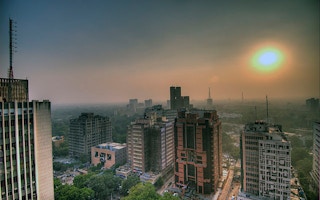This time last year my husband and I attended a protest in central Delhi against the unprecedented levels of air pollution in the city. I was nine months pregnant and listened as the doctors on stage talked about the health effects on unborn babies. The next day I gave birth to my son – thankfully, completely healthy. As we celebrate his first birthday this week we are once again experiencing toxic air that is literally off the scale.
I wake up in the morning to a cloud of smog inside our apartment. I follow my son around with an expensive air purifier as he crawls from one room to the next. I do not let him leave the apartment, and when I am outside I wear a mask, even in the car. Despite this, my lungs ache, my eyes sting, and I have the lingering cough that is now universal in Delhi.
For the last week the level of air pollution has spiked. It is always pretty bad – hovering between ‘unhealthy’ and ‘very unhealthy’ on the government’s Air Quality Index (AQI). But it is now firmly in the ‘hazardous’ category.
The level of PM 2.5 – the smallest particles that cause the most damage to health – are regularly reaching 999. This is the maximum recording the air pollution monitors can handle.We therefore do not actually know how bad it is. The World Health Organisation (WHO) says 25 is the maximum safe level of PM 2.5. For some reason, the government of India’s own safe limit of PM 2.5 is 60. Even by the government’s higher standard, we are nearly 17 times over the safe limit. We are even double the ‘hazardous’ level.
Forcing myself to research these statistics and write this piece induces rising panic and guilt. There is very little chance that my son will escape irreversible health damage after being exposed to this pollution. In 2012 (when levels of air pollution were much lower) the lung function of 43 percent of children was impaired. Breathing this level of toxic air is apparently equivalent to smoking 44 cigarettes a day. The impact this has on tiny growing lungs is too distressing to really think about.
So, are we being irresponsible parents by staying in Delhi? Unlike most, we have the resources and opportunities to allow us to relocate. Many of my friends have left, and some foreign embassies are struggling to attract and retain diplomats. Although it would be professionally and personally difficult to leave (we still love the city) – should we for the sake of my son’s health?
I want to stay and try and help fix the problem, rather than just run away. But, I am losing faith that the situation can ever get better, at least within my son’s childhood.
As the pollution has increased each year, so has the level of awareness and concern among the public. When I arrived in Delhi nearly six years ago, it was still fondly referred to as ‘fog’. Now everyone knows it is deadly smog and more and more people are wearing masks, it is widely reported in the media, and politicians are taking it seriously.
The Delhi government plans to start the third attempt to temporarily reduce the number vehicles on the roads through an ‘odd-even’ scheme. They have closed around 6,000 schools, banned the use of generators and firewood, and halted some construction in the city. They are even due to spray the city with water from helicopters in perhaps an ill-thought out plan to settle dust (and probably worsen our water crisis).
“
The reality is, Delhi, like the whole of India, has a lot of problems to fix, and only for a few weeks or months the air pollution is bad enough that it becomes the priority.
However, the root cause of the pollution is being ignored. Partly because no one seems sure on the culprit: the 10 million cars and motorbikes on the roads and thousands of old diesel trucks that cross the city at night, crop burning in neighbouring states, construction dust, Diwali firecrackers, burning garbage, and nearby industrial plants. Delhi is also geographically unlucky, sitting in a basin and when the temperature and winds drop the pollution gets trapped.
There are also a whole range of political, cultural and economic reasons for the lack of action. Firstly, as the capital city, Delhi is run by multiple levels of government, each controlled by a different political party. The city boundaries also merge into two neighbouring states, and millions commute into the city every day.
Taking decisive action requires putting aside political interests (and with a general election looming) and centrally coordinating across a number of states. The failure of the government to enforce a ban on crop burning also demonstrates how difficult it is to get people to adopt new practices – and how the poor need to be supported and compensated for doing so.
Ultimately, the biggest challenge to reducing air pollution in Delhi is the fact that it is seasonal. Ironically, if we suffered all year long (like many Chinese cities do), there would be sustained focus on the problem. However, as winter passes and the temperature increases, the pollution levels return to a mere ‘unhealthy’. And we shift to complaining about heat waves, water shortages and electricity blackouts.
The reality is, Delhi, like the whole of India, has a lot of problems to fix, and only for a few weeks or months the air pollution is bad enough that it becomes the priority.
So how do we keep up the pressure on politicians and the government all year long? London in the 1950s, Los Angeles in the 1970s and Mexico City in the 1990s should give us some ideas. They all beat the odds to reduce crippling levels of air pollution. I therefore can only hope that all of us in Delhi rise to the challenge, and before too much damage is done to my son, and all the other children in the city.
Elizabeth Gogoi is a consultant on climate change and renewable energy with Oxford Policy Management. This article is republished from Thomson Reuters Foundation.











